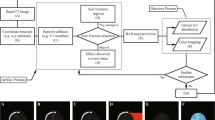Summary
In order to evaluate if it is practically possible to assess the volume of contused brain tissue from the CT pictures, a comparison has been carried out between the size of the cerebral contusion(s)-as estimated from the CT scans-and the post-traumatic CSF-CKBB activity, in a series of 29 patients with severe head injury. A clearance curve for the elimination of CKBB from the CSF was constructed.
The relation between contusion volume and CSF-CKBB-activity was not statistically significant, while the relationships between contusion volume and outcome, and between CSF-CKBB, as estimated at 6 hours after trauma from the clearance curve, and outcome, were.
Similar content being viewed by others
References
Bakay RAE, Ward Jr AA (1983) Enzymatic changes in serum and cerebrospinal fluid in neurological injury. J Neurosurg 58: 27–37
Hans P, Born JD, Albert A (1987) “Extrapolated” creatine kinase-BB isoenzyme activity in assessment of initial brain damage after severe head injury. J Neurosurg 66: 714–717
Hedman G, Rabow L (1979) CKBB-isoenzymes as a sign of cerebral injury. Acta Neurochir (Wien) [Suppl] 28: 108–112
Kjekshus JK, Vaagenes P, Hetland V (1980) Assessment of cerebral injury with spinal fluid CSF-CK in patients after cardiac resuscitation. Scand J Clin Lab Invest 40: 437–444
Upper M, Kishore PRS, Enas GGet al (1985) Computed tomography in the prediction of outcome in head injury. Am J Neurol Rad 6: 7–10
Maas AIR (1977) Cerebrospinal fluid enzymes in acute brain injury. J Neurol Neurosurg Psychiatry 40: 655–665
Nordby HK, Urdal P (1982) The diagnostic value of measuring creatine kinase BB activity in cerebrospinal fluid following acute head injury. Acta Neurochir (Wien) 65: 93–101
Rabow L, DeSalles AAF, Becker DPet al (1987) CSF brain creatine kinase levels and lactic acidosis in severe head injury. J Neurosurg 65: 625–629
Steiner L, Bergvall U, Zwetnow N (1975) Quantitative estimation of intracerebral and intraventricular hematoma by computer tomography. Acta Radiol [Suppl] (Stockh) 346: 143–154
Terent A, Ronquist G, Bergström Ket al (1981) Ischemic edema in stroke. A parallel study with computed tomography and cerebrospinal fluid markers of disturbed brain cell metabolism. Stroke 12: 33–40
Van Dongen KJ, Braakman R, Gelpke GJ (1983) The prognostic value of computerized tomography in comatose head-injured patients. J Neurosurg 59: 951–957
Wilkinson JH, Steciw B (1970) Evaluation of a new procedure for measuring serum creatine kinase activity. Clin Chem 16: 370–374
Author information
Authors and Affiliations
Rights and permissions
About this article
Cite this article
Rabow, L., Cook, D., Lipper, M.H. et al. Relationship between CT attenuation changes and post-traumatic CSF-CKBB-activity after severe head injury in man. Acta neurochir 100, 155–157 (1989). https://doi.org/10.1007/BF01403604
Issue Date:
DOI: https://doi.org/10.1007/BF01403604




